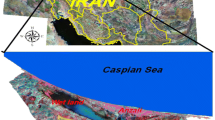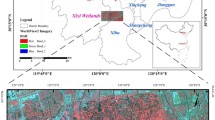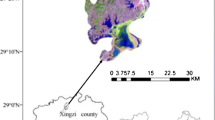Abstract
Wetland monitoring is crucial for understanding wetland changes and responses to natural and anthropogenic actions. In this research, Hangzhou Bay coastal wetland was selected as the study area to analyze spatial patterns and dynamic changes based on Landsat multitemporal imagery. A hybrid approach combining expert knowledge, decision tree, threshold technique, unsupervised classification and postprocessing was developed for wetland classification. Three typical sites were selected to analyze different change patterns. Over the last 10 years, the wetlands have undergone dramatic changes, continued to expand outwards due to natural accumulation and increased in area. At the same time, these wetlands have also partially decreased with artificial reclamation and urban construction. An analysis of typical sites found that the change in the western part of this region was dominated by natural accumulation and that in the central and eastern parts was dominated by reclamation due to geographical location and hydrological power. In general, wetlands are continually changing under the joint action of natural accumulation, artificial reclamation and urban construction. The local terrain, hydrology, soil, population, economy and policy also influence wetland changes. The results of wetland monitoring are essential for the protection and management of local wetlands.





Similar content being viewed by others
References
Adam E, Mutanga O, Rugege D (2010) Multispectral and hyperspectral remote sensing for identification and mapping of wetland vegetation: a review. Wetl Ecol Manage 18:281–296
Adler-Golden SM, et al (1999) Atmospheric correction for shortwave spectral imagery based on MODTRAN4. In: Imaging Spectrometry V. International Society for Optics and Photonics, pp 61–70
Allen YC (2012) Using multi-temporal remote sensing imagery and inundation measures to improve land change estimates in coastal wetlands. Estuaries Coasts 35:190–200
Baker C, Lawrence R, Montagne C, Patten D (2006) Mapping wetlands and riparian areas using Landsat ETM + imagery and decision-tree-based models. Wetlands 26:465–474
Barbier EB, Hacker SD, Kennedy C, Koch EW, Stier AC, Silliman BR (2011) The value of estuarine and coastal ecosystem services. Ecol Monogr 81:169–193
Bwangoy J-RB, Hansen MC, Roy DP, Grandi GD, Justice CO (2009) Wetland mapping in the Congo Basin using optical and radar remotely sensed data and derived topographical indices. Remote Sens Environ 114:73–86
Chen XL, Zhao HM, Li PX, Yin ZY (2006) Remote sensing image-based analysis of the relationship between urban heat island and land use/cover changes. Remote Sens Environ 104:133–146
Chen J, Wang L, Li Y, Zhang W, Fu X, Le Y (2012) Effect of Spartina alterniflora invasion and its controlling technologies on soil microbial respiration of a tidal wetland in Chongming Dongtan, China. Ecol Eng 41:52–59
Corcoran JM, Knight JF, Gallant AL (2013) Influence of multi-source and multi-temporal remotely sensed and ancillary data on the accuracy of random forest classification of wetlands in Northern Minnesota. Remote Sens 5:3212–3238
Davranche A, Lefebvre G, Poulin B (2009) Wetland monitoring using classification trees and SPOT-5 seasonal time series. Remote Sens Environ 114:552–562
de Araujo Barbosa CC, Atkinson PM, Dearing JA (2015) Remote sensing of ecosystem services: a systematic review. Ecol Ind 52:430–443. https://doi.org/10.1016/j.ecolind.2015.01.007
El-Hattab MM (2016) Applying post classification change detection technique to monitor an Egyptian coastal zone (Abu Qir Bay). Egypt J Remote Sens Space Sci 19:23–36
Foody GM (2002) Status of land cover classification accuracy assessment. Remote Sens Environ 80:185–201
Frohn RC, D’Amico E, Lane C, Autrey B, Rhodus J, Liu H (2012) Multi-temporal sub-pixel Landsat ETM + classification of isolated wetlands in Cuyahoga County, Ohio, USA. Wetlands 32:289–299
Halabisky M, Moskal LM, Gillespie A, Hannam M (2016) Reconstructing semi-arid wetland surface water dynamics through spectral mixture analysis of a time series of Landsat satellite images (1984–2011). Remote Sens Environ 177:171–183. https://doi.org/10.1016/j.rse.2016.02.040
Haralick RM, Shanmugam K (1973) Textural features for image classification. IEEE Trans Syst Man Cybern 6:610–621
Henderson FM, Lewis AJ (2008) Radar detection of wetland ecosystems: a review. Int J Remote Sens 29:5809–5835. https://doi.org/10.1080/01431160801958405
Hess LL, Melack JM, Novo EMLM, Barbosa CCF, Gastil M (2003) Dual-season mapping of wetland inundation and vegetation for the central Amazon basin. Remote Sens Environ 87:404–428
Hussain M, Chen D, Cheng A, Wei H, Stanley D (2013) Change detection from remotely sensed images: from pixel-based to object-based approaches. ISPRS J Photogramm Remote Sens 80:91–106
Jiang TT, Pan JF, Pu XM, Wang B, Pan JJ (2015) Current status of coastal wetlands in China: degradation, restoration, and future management. Estuar Coast Shelf Sci 164:265–275
Kauth RJ, Thomas G (1976) The tasselled cap—a graphic description of the spectral-temporal development of agricultural crops as seen by Landsat. In: LARS Symposia, p 159
Kirwan ML, Megonigal JP (2013) Tidal wetland stability in the face of human impacts and sea-level rise. Nature 504:53
Klemas V (2010) Remote sensing techniques for studying coastal ecosystems: an overview. J Coast Res 27:2–17
Klemas V (2011) Remote sensing techniques for studying coastal ecosystems: an overview. J Coast Res 27:2–17
Klemas VV (2015) Coastal and environmental remote sensing from unmanned aerial vehicles: an overview. J Coast Res 315:1260–1267
Kuenzer C, Bluemel A, Gebhardt S, Quoc TV, Dech S (2011) Remote sensing of mangrove ecosystems: a review. Remote Sens 3:878–928. https://doi.org/10.3390/rs3050878
Liu Y, Feng Y (2016) Simulating the impact of economic and environmental strategies on future urban growth scenarios in Ningbo, China. Sustainability 8:1045. https://doi.org/10.3390/su8101045
Lu D, Weng Q (2007) A survey of image classification methods and techniques for improving classification performance. Int J Remote Sens 28:823–870. https://doi.org/10.1080/01431160600746456
Lu D, Li G, Moran E (2014) Current situation and needs of change detection techniques. Int J Image Data Fusion 5:13–38
Mahdavi S, Salehi B, Granger J, Amani M, Brisco B, Huang W (2017) Remote sensing for wetland classification: a comprehensive review. GIsci Remote Sens 55:623–658
Mao D et al (2016) China’s wetlands loss to urban expansion. Land Degrad Dev 20:30. https://doi.org/10.1002/ldr.2939
McFeeters SK (1996) The use of the normalized difference water index (NDWI) in the delineation of open water features. Int J Remote Sens 17:1425–1432
Melissa M, Paul B (2009) Mapping northern wetlands with high resolution satellite images and lidar. Wetlands 29:248–260
Mountrakis G, Im J, Ogole C (2011) Support vector machines in remote sensing: a review. ISPRS J Photogramm Remote Sens 66:247–259. https://doi.org/10.1016/j.isprsjprs.2010.11.001
Ouyang Z-T, Zhang M-Q, Xie X, Shen Q, Guo H-Q, Zhao B (2011) A comparison of pixel-based and object-oriented approaches to VHR imagery for mapping saltmarsh plants. Ecol Inform 6:136–146. https://doi.org/10.1016/j.ecoinf.2011.01.002
Ozesmi SL, Bauer ME (2002) Satellite remote sensing of wetlands. Wetl Ecol Manage 10:381–402
Peña-Barragán JM, Ngugi MK, Plant RE, Six J (2011) Object-based crop identification using multiple vegetation indices, textural features and crop phenology. Remote Sens Environ 115:1301–1316
Pendleton L et al (2012) Estimating global “blue carbon” emissions from conversion and degradation of vegetated coastal ecosystems. PLoS ONE 7:e43542
Pflugmacher D, Cohen WB, Kennedy RE (2012) Using Landsat-derived disturbance history (1972–2010) to predict current forest structure. Remote Sens Environ 122:146–165
Quynh Trang NT, Toan LQ, Huyen Ai TT, Vu Giang N, Viet Hoa P (2016) Object-based vs. pixel-based classification of mangrove forest mapping in Vien An Dong commune, Ngoc Hien District, Ca Mau Province Using VNREDSat-1 Images. Adv Remote Sens 05:284–295. https://doi.org/10.4236/ars.2016.54022
Rokni K, Ahmad A, Selamat A, Hazini S (2014) Water feature extraction and change detection using multitemporal landsat imagery. Remote Sens 6:4173–4189
Rouse JW Jr, Haas R, Schell J, Deering D (1974) Monitoring vegetation systems in the Great Plains with ERTS. NASA Special Publication, Washington, DC
Rundquist DC, Narumalani S, Narayanan RM (2001) A review of wetlands remote sensing and defining new considerations. Remote Sens Rev 20:207–226. https://doi.org/10.1080/02757250109532435
Sader SA, Ahl D, Liou W-S (1995) Accuracy of landsat-TM and GIS rule-based methods for forest wetland classification in Maine. Remote Sens Environ 53:133–144
Shao X, Yang W, Wu M (2015) Seasonal dynamics of soil labile organic carbon and enzyme activities in relation to vegetation types in Hangzhou Bay tidal flat wetland. PLoS ONE 10:e0142677
Singh A (1989) Review article digital change detection techniques using remotely-sensed data. Int J Remote Sens 10:989–1003
Wright C, Gallant A (2006) Improved wetland remote sensing in Yellowstone National Park using classification trees to combine TM imagery and ancillary environmental data. Remote Sens Environ 107:582–605
Xu H (2006) Modification of normalised difference water index (NDWI) to enhance open water features in remotely sensed imagery. Int J Remote Sens 27:3025–3033
Zha Y, Gao J, Ni S (2003) Use of normalized difference built-up index in automatically mapping urban areas from TM imagery. Int J Remote Sens 24:583–594
Zhang J (2010) Multi-source remote sensing data fusion: status and trends. Int J Image Data Fusion 1:5–24. https://doi.org/10.1080/19479830903561035
Zhang Y, Lu D, Yang B, Sun C, Sun M (2011) Coastal wetland vegetation classification with a Landsat Thematic Mapper image. Int J Remote Sens 32:545–561. https://doi.org/10.1080/01431160903475241
Zhu Z, Woodcock CE (2014) Continuous change detection and classification of land cover using all available Landsat data. Remote Sens Environ 144:152–171. https://doi.org/10.1016/j.rse.2014.01.011
Zomer RJ, Trabucco A, Ustin SL (2008) Building spectral libraries for wetlands land cover classification and hyperspectral remote sensing. J Environ Manage 90:2170–2177
Acknowledgements
Nan Li acknowledges the financial support from the Zhejiang Province—Chinese Academy of Forestry joint-supported Forestry Science and Technology Program (2015SY01 and 2018SY03), the Priority Academic Program Development of Jiangsu Higher Education Institutions (PAPD), Postgraduate Research & Practice Innovation Program of Jiangsu Province (KYCX17_0819) and the Doctorate Fellowship Foundation of Nanjing Forestry University and and Zhejiang Provincial Natural Science Foundation (Grant# LQ19D010010).
Author information
Authors and Affiliations
Contributions
DL and YZ developed the analytical framework. NL processed the data, classified land cover, detected the change and wrote the initial manuscript. LL and MW collected field survey data. All authors contributed to the editing/discussion of the manuscript.
Corresponding author
Ethics declarations
Conflicts of interest
The authors declare no conflict of interest.
Electronic supplementary material
Below is the link to the electronic supplementary material.
Rights and permissions
About this article
Cite this article
Li, N., Li, L., Lu, D. et al. Detection of coastal wetland change in China: a case study in Hangzhou Bay. Wetlands Ecol Manage 27, 103–124 (2019). https://doi.org/10.1007/s11273-018-9646-3
Received:
Accepted:
Published:
Issue Date:
DOI: https://doi.org/10.1007/s11273-018-9646-3




